Graphics Design
10 Unique Sources of Creative Design Inspiration You Haven’t Tried Yet
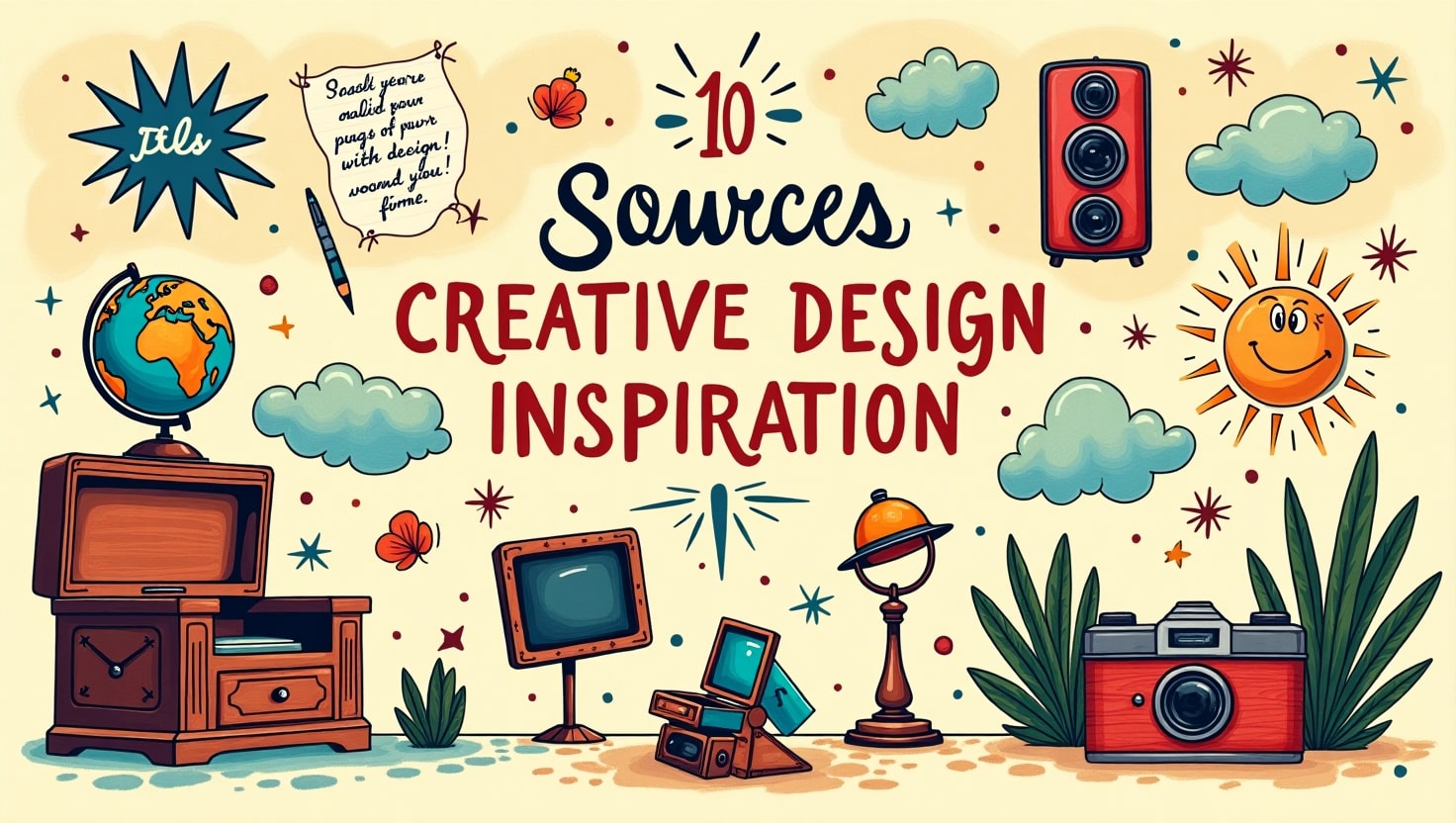
10 Unique Sources of Creative Design Inspiration You Haven’t Tried Yet
Creative design inspiration journeys into endless creativity but require new sources of inspiration for Creative Design during occasional moments. Your creative design inspiration process can result in remarkable achievements by exploring sources beyond typical ones regardless of your professional role as graphic designer web developer or fashion creator. Your experience on Pinterest together with Behance and Dribbble remains beneficial yet restricts your creative thinking because it focuses mainly on popular trends. This article presents a list of 10 uncommon yet effective Creative Design Inspiration sources which may be new to you.
1. Nature’s Hidden Wonders
The microscopic world of nature serves as one of the most incredible creative design inspirations although few people have truly explored it. Watching the complex leaf patterns and tree bark textures and symmetrical patterns in snowflakes enables designers to generate new innovative design concepts. Observing sunset colors and cloud patterns together with the structural arrangement of rock layers reveals unforeseen design ideas to you.
Moving closer to nature through macro photography of flowers and water droplets alongside insects produces exceptional design pattern references showing fine details. Natural approaches to Creative Design Inspiration produce unique design ideas which conventional designs do not typically display.
2. Historical Artifacts and Vintage Ephemera
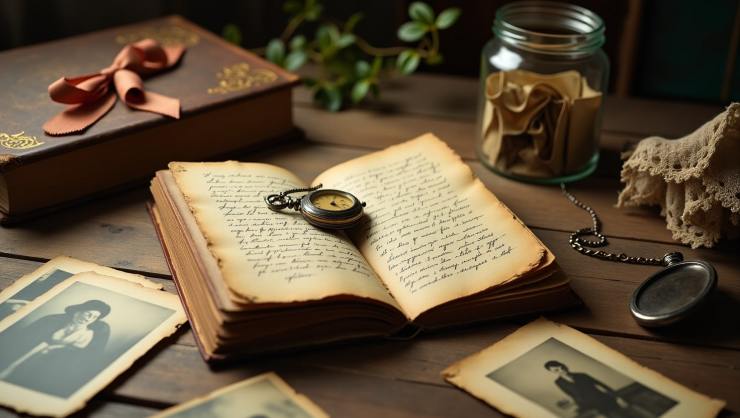
History contains numerous artistic ideas that inspire design creativity.Companionเดิม Design projects benefit from a nostalgic innovative look when designers use items like old newspapers, postcards and product labels from various past decades.
The study of old artistic movements becomes possible by visiting museums together with archives and flea markets. Creative design inspiration contemporary designs of Art Nouveau Bauhaus and Victorian architecture provide valuable source material to modern creative projects. Restoring such historical features enables designers to develop modern designs that emphasize permanent value.
3. Abstract and Surrealist Photography
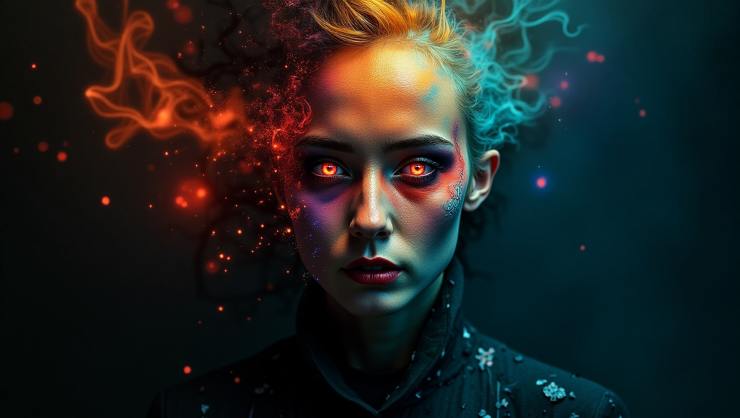
Photography functions as Creative Design Inspiration through standard image practices and surrealist and abstract photographs drive design creativity to its peak. Playing with lighting together with reflections and distorted perspective permits you to produce disturbing images that provoke innovative thinking.
You should test different photography techniques such as motion blur and double exposure as well as infrared photography to generate remarkable otherworldly images. The simple combination of black-and-white tones during an experiment leads you to view shapes, forms and shadows with fresh perspective. Your design quality will improve remarkably when you observe abstract photographic techniques or create experimental photographs.
4. Experimental Typography in Street Art

Many designs heavily depend on typography which you can easily discover through studying street art and graffiti. Since it deviates from standard typefaces street typography provides expressive and raw elements together with unpredictable characteristics which enable traditional design parameters to break.
Explore your city by photographing the written signage along with public murals as well as protest signs. Various spontaneous local creations use storytelling mechanisms as their core component. Street typography serves as a suitable option for creative design inspiration when making a logo or brand project.
5. Music Visualization and Sound Waves
Only a small percentage of designers recognize sound as an unexplored source for design creativity although music shares a strong relationship with design concepts. The combination of sound waves with frequency patterns and music-based color selection leads to fresh design ideas.
Audio-to-visual conversion tools include spectrograms and waveform visualizers among their functions. Using this type of functionality enables you to make expressive posters and album covers along with digital visualizations that display sound elements. Creating designs based on music enables your work to capture emotional intensity alongside rhythmic qualities which standard techniques cannot transmit.
6. Dreams and Subconscious Imagery
Dream images consist of peculiar symbols that produce original ideas for designers to use as Creative Design Inspirations. Writing down your dreams in a journal allows you to record distinctive images that your subconscious develops.
The diverse nature of dream elements together with their spontaneous connections gives rise to abstract illustrations and product designs or user interface elements. Salvador Dalí and René Magritte incorporated dreamlike visual elements similar to surrealism so you could adopt their approach in designing your upcoming project through your dream inspiration.
7. Science and Mathematics in Design

Mathematics together with science appear unconventional as Creative Design Inspiration sources although they present significant potential for design innovation. Creative designers find widespread value in nature-based Fibonacci sequences and fractals along with geometric patterns because they adapt these elements for their designs.
The golden ratio functions as a mathematical rule which generates elegant dimensional relationships. The design philosophy finds its optimal use in website layouts as well as logo developments and fashion illustrations. New design work benefits by introducing elements derived from molecular structures and fluid dynamics and astronomy.
8. Children’s Drawings and Naïve Art

The clearest creative design inspirations often appear in basic places. The drawings of children represent natural unadulterated self-expression which exists beyond standard design principles. The creative freedom of children in using colors and proportions and storytelling helps people discover their own artistic liberation.
Artists along with designers use childlike spontaneous techniques in their work to achieve professional growth. To overcome design blockages start your drawing with childlike freehand methods by using crayons combined with spontaneous doodles and random colors.
9. Unusual Cultural Festivals and Traditions
Each culture selects special holidays for celebration which include extravagant costumes along with decorative schemes and theatrical displays. Creative Design Inspiration manifests through these events which present extraordinary bold color schemes and intricate design patterns together with significant meaningful symbols.
The Day of the Dead celebration in Mexico presents itself through lively skull artwork while Japanese Tanabata festivities display elegant paper artwork. Your academic research into cultural traditions enables you to integrate powerful cultural elements into your projects while pushing your creative brainstorming.
10. Artificial Intelligence and Algorithm-Generated Art

Technology advances from artificial intelligence combined with algorithms create significant changes in the field of design. Human designers can use platforms such as Deep Dream, Runway ML and generative art to generate visuals which merge their creativity with the analytical skills of machines. The unexpected results which AI produces function exceptionally well as inspirational material for creative design work.
Experimenting with AI-generated designs will help you find unexpected aspects which can be developed into original designs. Treating artificial intelligence as an aesthetic enhancement rather than creative replacement gives diverse opportunities to design thinking.
Frequently Asked Questions (FAQs)
What methods do I have to integrate these resources into my daily design workflow? Spend one week each month selecting a brand new source for investigation. Develop notes based on your inspiration sources and construct mood boards prior to attempting smaller test projects that will lead to large design implementations.
Non-designers may effectively use these sources for generating design inspiration. A: Absolutely! The Creative Design Inspiration platform benefits writers and photographers as well as entrepreneurs to strengthen their branding and marketing content together with storytelling strategies.
Because exploring these inspirations requires any kind of specialized or costly equipment. A: Not at all! The inspirations demand only observation combined with curiosity and experimental approaches.
Does failing to find inspiration from these sources make you feel hopeless? A: No. If these inspirations do not spark ideas for you then try mixing and matching different sources or taking a break to come back with new perspectives. Each person faces inspiration in different ways. Combine different sources or simply step away for a while before reviewing the sources with different perspective.
Which strategies can I use to protect originality within my designs which incorporate these sources? You should analyze all delightful aspects of original elements before you transform them into your special creative interpretation.
The use of these distinctive sources will allow you to improve your creative output and produce innovative design work that distinguishes itself in your industry. Happy designing!
Graphics Design
How to Create an Eye-Catching Graphic Design Portfolio (with Examples)
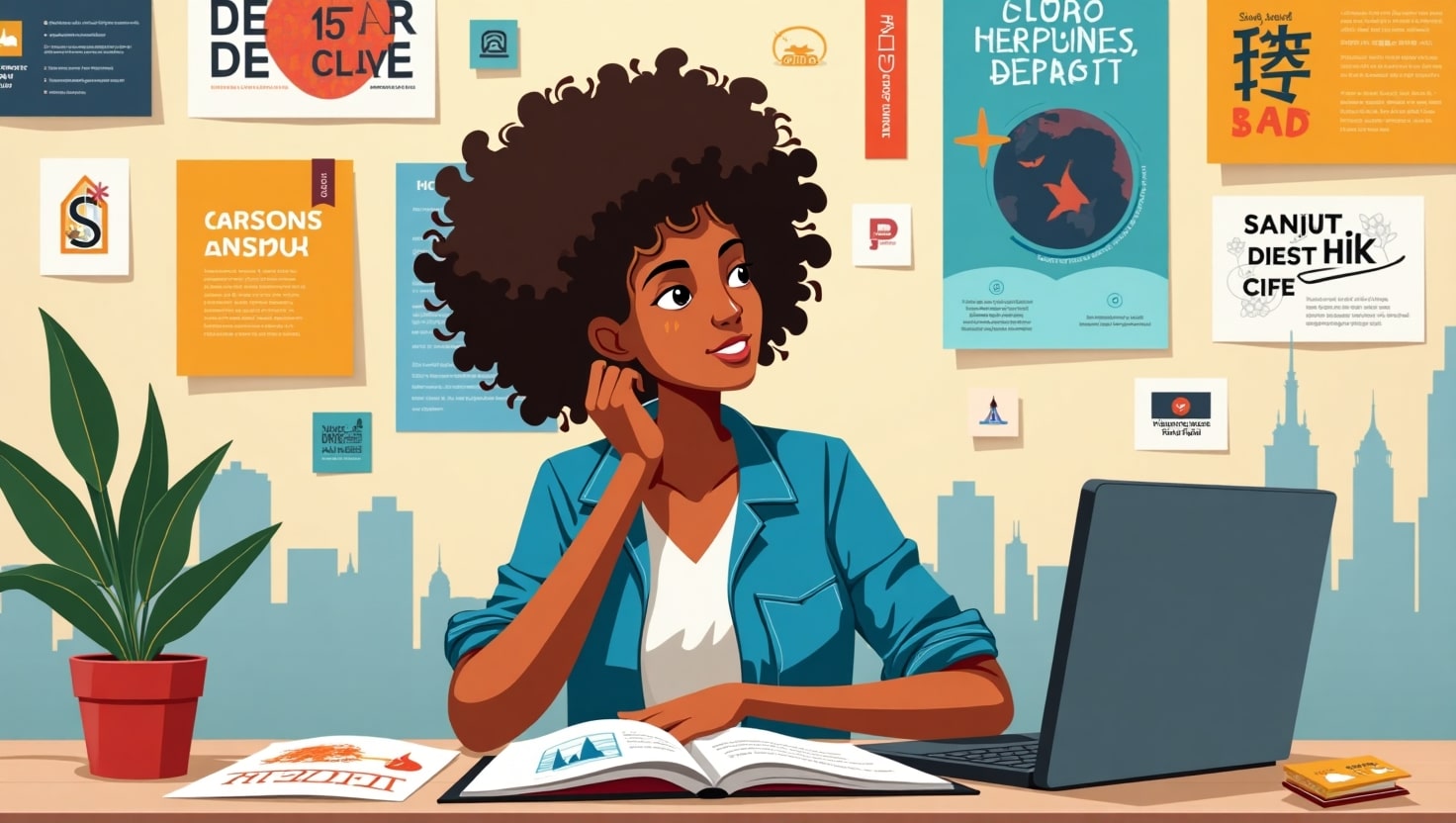
How to Create an Eye-Catching Graphic Design Portfolio (with Examples)
Introduction: Importance of a Portfolio in 2025
The graphic design portfolio industry in 2025 is more competitive than ever. With the rise of remote work and global freelancing platforms, clients often hire designers they’ve never met in person. This means your graphic design portfolio is your strongest tool to build credibility and attract opportunities.
Think of your portfolio as your digital resume—but far more powerful. While a resume lists your skills, a portfolio shows them in action. Whether you’re applying for a full-time job, pitching to clients, or showcasing your creative journey on platforms like Behance, your portfolio acts as a visual proof of your abilities.
In fact, many creative directors say they decide within the first 30–60 seconds whether a graphic design portfolio stands out or not. So, in 2025, having an updated, polished, and well-structured portfolio isn’t optional—it’s essential.
Elements of a Strong Portfolio

A portfolio isn’t just about throwing all your work into one place. It should be a carefully curated selection that highlights your strengths. Here are the key elements every designer should include:
- High-Quality Work Samples
Select only your best projects—those that truly represent your skills and creativity. Show variety but avoid including every single design you’ve ever made. - Consistency & Style
Your portfolio should reflect your personal brand. If you specialize in minimalistic design, make sure that aesthetic carries through your work. Consistency gives clients confidence that you can deliver a clear vision. - Storytelling Through Projects
Don’t just upload a logo or a poster. Share the process—what was the problem, how did you approach it, and what was the final solution? Clients love to see your thought process as much as the final outcome. - Professional Presentation
Use a clean, user-friendly design. Keep navigation simple. A messy graphic design portfolio can turn clients away even if your work is good. - Personal Branding
Add your name, logo, or personal design identity. Think of it as designing a brand for yourself—this makes your portfolio memorable.
What to Include (Case Studies, Testimonials, Extras)
To make your graphic design portfolio stand out, go beyond just images. Consider adding:
- Case Studies:
For each project, write a short breakdown: the client’s brief, your graphic design portfolio thinking, challenges you solved, and the final outcome. For example, if you designed a new logo for a coffee shop, explain how you researched competitor logos, chose a warm color palette, and created a design that connects with the brand’s identity. - Client Testimonials:
Even a short testimonial can add credibility. Something like “Working with [Your Name] was smooth and creative—our brand now feels modern and professional” carries a lot of weight. - Before & After Comparisons:
Clients love to see the transformation. Show old branding side by side with your redesign. This visually proves your impact. - Unpaid or Practice Work:
Especially for beginners, including self-initiated projects (like redesigning a famous brand’s website for practice) shows initiative and creativity.
Tools to Build a Portfolio

You don’t need advanced coding skills to build a great graphic design portfolio. Here are the best tools in 2025:
- Behance:
Still one of the most popular platforms for creative professionals. Easy to use, free, and highly visible to recruiters and agencies worldwide. - Adobe Portfolio:
Included with Adobe Creative Cloud subscriptions, it allows you to create sleek, professional sites linked directly to your Behance profile. - Dribbble:
Perfect for UI/UX and interactive designers. Great for showcasing quick snapshots of projects and connecting with design communities. - Personal Website (WordPress, Squarespace, Wix):
Having your own site gives you full control over branding. You can add blogs, SEO-friendly content, and contact forms to attract clients directly. - Canva & Figma Showcases:
For those who want quick, modern layouts, these tools also allow you to present mock portfolios in a creative way.
Best Layout and Design Practices

Your portfolio should not only show great work but also be a great experience for the viewer. Follow these design practices:
- Minimalism Wins: Avoid clutter. Let your work breathe with white space.
- Show Best Work First: The opening page should immediately grab attention. Place your strongest project right at the top.
- High-Resolution Images: Blurry or pixelated designs make your portfolio look unprofessional.
- Clear Project Titles & Descriptions: Label each project with context, not just “Logo Design 1.” Use names like “Rebranding Project for XYZ Coffee House.”
- Mobile Responsiveness: Many clients browse portfolios on smartphones—make sure yours looks flawless on all devices.
- Interactive Elements (Optional): Some designers add hover effects or animations to make their portfolio more engaging, but keep it user-friendly.
Mistakes to Avoid
Even talented designers can ruin their graphic design portfolio by making common mistakes. Here’s what to avoid:
- Including Everything: Quality > Quantity. A graphic design portfolio with 7 excellent projects is better than one with 25 average ones.
- No Explanations: Uploading just pictures without any context can confuse clients. Always include project goals and outcomes.
- Outdated Work: Don’t show designs from years ago that don’t reflect your current skill level.
- Poor Navigation: If clients struggle to browse, they may leave quickly.
- Ignoring Personal Branding: Treat your portfolio like your brand—consistent fonts, colors, and style are crucial.
FAQ
Q1: Can beginners create a graphic design portfolio with practice work?
Yes. Many successful designers started by creating mock projects, redesigning existing brands, or inventing fictional clients. Employers and clients don’t always care if the work was “real”—what matters is how well you present your skills and ideas.
Q2: Should I include unpaid projects?
Definitely. If you did work for a friend, charity, or even a personal project, include it if it demonstrates your design abilities. Many clients respect unpaid or volunteer work, especially if it shows passion and creativity.
Q3: How many projects should I include?
Between 6–10 strong projects is usually enough. Too few makes it seem like you lack experience; too many can overwhelm.
Q4: Do I need both a website and a Behance/Dribbble portfolio?
Not necessarily, but having both increases visibility. A personal website gives you branding control, while platforms like Behance bring traffic from the design community.
Conclusion: Keep Updating and Refining
A graphic design portfolio is not a “one and done” project. It’s a living document of your skills, style, and growth. As trends evolve and you take on new projects, your portfolio should evolve too.
In 2025, the designers who succeed aren’t just the most creative—they’re the ones who consistently update, refine, and adapt their portfolios to stay relevant. Whether you’re a beginner building with practice projects or a professional showcasing high-profile client work, treat your portfolio as your most valuable asset.
Remember: your portfolio is your voice in the design world—make sure it speaks clearly, confidently, and creatively.
Graphics Design
15 Freelance Graphic Design Tips to Boost Your Career in 2025
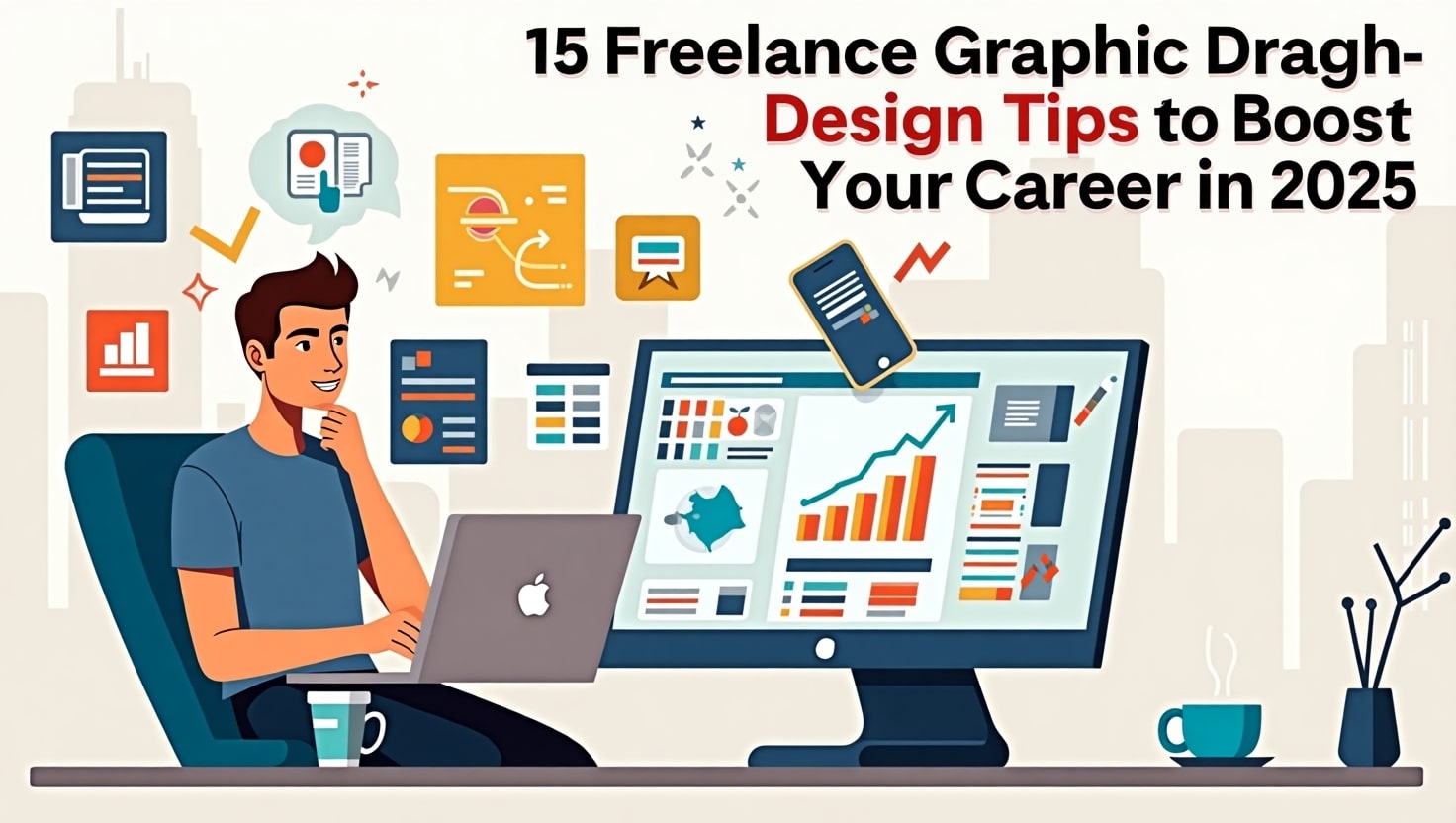
15 Freelance Graphic Design Tips to Boost Your Career in 2025
Introduction: Why Freelancing Is Booming in 2025
The freelance graphic design tips economy is exploding—and graphic designers are at the heart of it. In 2025, remote work continues to dominate the creative industry. Businesses, startups, and even content creators are constantly looking for high-quality visual content to communicate their brands. From social media graphics and websites to product packaging and logos, freelance graphic designers are more in demand than ever before.
Why? Flexibility, creativity, and cost-efficiency. Hiring freelancers allows companies to scale design work without the overhead of full-time salaries, while freelancers gain freedom over when, where, and how they work.
But success doesn’t come just by being good at design. It takes business savvy, communication skills, marketing, and persistence. In this comprehensive guide, you’ll find 15 expert-backed freelance graphic design tips to help you stand out and succeed in 2025.
Tip #1 – Build a Killer Portfolio That Sells for You

Your portfolio is your personal storefront of freelance graphic design tips. It’s not just a collection of pretty images—it’s your proof of value. In 2025, clients want to see results-driven design:
- Case studies that show how your designs improved conversions or brand awareness.
- Real client testimonials tied to specific projects.
- A mix of personal and client work to show creativity and versatility.
Use platforms like Behance, Dribbble, or your own website. Make sure it’s mobile-friendly, loads fast, and tells a story. Keep updating it with your latest and best work. Don’t include every project—only those that align with the kind of clients you want to attract.
💡 Pro Tip: Add context to each project. Don’t just show the design—explain the client’s problem, your approach, tools used, and the results.
Tip #2 – Use Contract Templates to Protect Yourself
One of the fastest ways to lose time, money, and peace of mind is to work without a contract. Whether it’s a $50 logo or a $5,000 branding package, always have a signed agreement.
A good contract should include:
- Scope of work (what’s included and what’s not)
- Timeline and deadlines
- Payment terms (50% upfront is common)
- Revision policy
- Ownership and usage rights
Use platforms like Hello Bonsai, AND.CO, or Docracy to get started. These services offer customizable, legally reviewed freelance contracts. Even a simple Google Docs template is better than nothing.
Tip #3 – Learn How to Price Your Services Strategically

Freelance graphic design tips Pricing is tricky for every freelancer—especially in the beginning. Charge too little, and you look inexperienced. Charge too much, and you risk scaring away potential clients.
Start by calculating your minimum hourly rate using this formula:
(Monthly Expenses + Profit Goal) ÷ Billable Hours = Base Hourly Rate
Then, experiment with project-based pricing and value-based pricing as you grow. Value-based pricing means charging based on the impact your work creates. For example, a logo for a small bakery and one for a tech startup shouldn’t cost the same, even if both take 5 hours.
Research what others charge in your niche on platforms like Upwork, Fiverr Pro, or Freelancer’s Union reports.
Tip #4 – Focus on One Niche (At First)
Generalists struggle more than specialists—especially when starting out. If you market yourself as “a designer for everyone,” you’ll likely end up attracting no one.
Instead, pick a niche such as:
- Logo & brand identity design for startups
- Social media design for beauty brands
- E-commerce packaging for sustainable products
- T-shirt and apparel design for streetwear brands
By narrowing down, you:
- Attract more targeted leads
- Become more confident in your pricing
- Build authority faster
When you started gives someone freelance graphic design tips you’ve established yourself in one niche, you can expand your services or pivot as needed.
Tip #5 – Use Social Proof to Build Trust

In the freelance world, trust is currency. Social proof—like reviews, testimonials, case studies, and client logos—tells potential clients, “Others trust me. You should too.”
How to collect social proof:
- Ask for testimonials after successful projects.
- Capture email feedback and turn it into quotes.
- Post client shoutouts and reviews on your portfolio and social channels.
- Include before-and-after results or transformation stats.
Tools like Trustpilot, Clutch, and Google Reviews can help build credibility when working with international clients.
Tip #6 – Network in the Right Places
Freelance graphic design tips who network smartly build thriving careers. You don’t need a massive following—you need the right people to know you.
Places to connect with potential clients:
- LinkedIn: Optimize your profile, post helpful content, and DM leads.
- Twitter/X: Follow founders, startups, and marketers in your niche.
- Facebook Groups: Join industry-specific groups for job leads.
- Design communities: Behance, Dribbble, DeviantArt, or Reddit (r/freelance, r/designjobs)
You don’t have to be salesy—just be visible and helpful. Share your insights, process, and design stories regularly.
Tip #7 – Invest in Essential Tools
Your toolkit can boost or block your freelance graphic design tips. In 2025, here are tools most freelancers rely on:
Design Tools
- Adobe Photoshop & Illustrator – Industry standard
- Figma – UI/UX and collaborative design
- Affinity Designer – Affordable and powerful
- Canva Pro – Quick mockups and templates
Project Management & Admin
- Notion / Trello – Project planning and to-do tracking
- Clockify / Toggl – Time tracking
- Wave / QuickBooks – Invoicing and accounting
- Google Workspace – Emails, Docs, Drive
Stay organized to freelance graphic design tips avoid burnout and impress clients with professionalism.
Tip #8 – Set a Routine and Respect Your Time
Freelance graphic design tips often work more hours than employees—because they blur boundaries. Set working hours that match your lifestyle and stick to them. Create a structure for your day:
- Morning: Admin, emails, planning
- Midday: Deep creative work
- Late afternoon: Revisions or meetings
- Evening: Learning or rest
Use Pomodoro timers and digital calendars to stay on track. Taking breaks, setting priorities, and knowing when to say “no” are all part of time mastery.
Tip #9 – Learn the Business Side of Freelancing
Freelance graphic design tips is your craft. But business is your engine. You need to know how to:
- Write proposals
- Send invoices and track payments
- Negotiate contracts
- Market yourself online
- Pay taxes and track expenses
Many designers learn the hard way by making costly mistakes. Speed up the learning curve with resources like:
- “The Freelancer’s Bible” by Sara Horowitz
- Freelance Business Bootcamps on Skillshare
- YouTube channels like The Futur or Roberto Blake
Tip #10 – Create a Strong Personal Brand

A personal brand is how people perceive you—even before they hire you. In a competitive field, branding sets you apart.
Steps to build your brand:
- Create a consistent logo, color scheme, and typography
- Use the same username across platforms
- Share your process, behind-the-scenes content, and success stories
- Define a mission (Who do you serve? What problems do you solve?)
When people see your name, they should immediately freelance graphic design tips associate you with a specific design style or industry niche.
Tip #11 – Stay Updated With Design Trends
Trends in typography if freelance graphic design tips, color schemes, layouts, and platforms change rapidly. What worked in 2023 might look outdated in 2025. Stay sharp by:
- Following top designers on Instagram, Behance, and Pinterest
- Reading blogs like CreativeBloq, Smashing Magazine, and Adobe Creative Cloud Blog
- Joining online classes on platforms like Domestika, Coursera, and Udemy
- Participating in design challenges (e.g., #DailyLogoChallenge, 36 Days of Type)
The more you evolve, the more valuable you become to clients looking for fresh, modern visuals.
Tip #12 – Offer More Than Just Design

Think beyond the canvas. Many clients need more than a beautiful design—they want strategy, branding advice, content help, and implementation.
You can increase your income by offering:
- Brand style guides
- Social media kits
- Copywriting support
- Print file preparation
- UX strategy
Even packaging your services into design bundles (e.g., logo + business card + brand guide) can help you earn more while providing convenience to clients.
Tip #13 – Turn Projects Into Case Studies

Anyone can show a logo. But telling the story behind the design sets you apart.
How to write a mini case study:
- The Client: Who they are and what they do
- The Challenge: What problem were they facing?
- The Solution: How did you approach the design?
- The Result: What impact did it make? (metrics if possible)
- The Testimonial: What did the client say?
Case studies show future clients that you’re more than a designer—you’re a problem solver.
Tip #14 – Ask for Referrals and Repeat Work
Word-of-mouth is still the most powerful form of marketing. After a successful project, ask:
“Do you know anyone else who might need graphic design services?”
Stay in touch with past clients. Send holiday greetings, share your latest work, or offer special discounts to encourage repeat projects.
If you impress someone once, there’s a high chance they’ll come back or refer you to others.
Tip #15 – Stay Consistent and Keep Learning
Freelance graphic design tips success takes time. You might go weeks without clients or face sudden rejections. That’s normal. The key is to stay consistent:
- Keep marketing even when you’re busy
- Keep learning even when you’re skilled
- Keep delivering even when it’s difficult
Freelancing is a marathon, not a sprint. Stay humble, keep building, and trust the process.
Where to Find Clients in 2025

Here are some reliable platforms and places to get freelance gigs:
| Platform | Best For |
| Upwork | Long-term contracts & serious clients |
| Networking, direct leads | |
| Fiverr Pro | Quick jobs, brand exposure |
| Toptal | Premium clients, strict vetting |
| Behance | Portfolio views + job listings |
| 99Designs | Design contests, niche projects |
| Design Facebook Groups | Networking and job postings |
Best Tools for Freelance Designers in 2025

| Category | Tools |
| Design | Adobe CC, Figma, Affinity, Canva Pro |
| Admin | Notion, Trello, ClickUp |
| Invoicing | Wave, Payoneer, QuickBooks |
| Time Tracking | Toggl, Clockify |
| Contracts | Hello Bonsai, AND.CO |
| Communication | Zoom, Slack, Gmail |
| File Storage | Google Drive, Dropbox |
FAQs
How much should a freelance designer charge?
Rates vary widely. Here’s a general guide in 2025:
- Beginners: $15–$30/hour
- Intermediate: $40–$75/hour
- Advanced: $100–$200/hour or value-based
Use pricing calculators or research competitors. Don’t race to the bottom—race to the top value.
What’s the biggest mistake beginners make?
Freelance graphic design tips undercharging and working without contracts. Many also try to please every client instead of focusing on quality work within their niche. Learn to say “no” to bad-fit projects.
Conclusion: Design Your Future with Confidence
Freelance graphic design tips as a graphic designer is no longer just a side hustle—it’s a full-time career path filled with creative freedom and global opportunity. But to succeed in 2025, you need more than freelance graphic design tips skills. You need strategy, consistency, and confidence.
By following these 15 freelance graphic design tips, you’re not just surviving—you’re thriving. Keep evolving, keep creating, and remember: your career is your best design project.
Graphics Design
Top 10 Best Graphic Design Tools for Beginners in 2025 (Free & Paid)

Top 10 Best Graphic Design Tools for Beginners in 2025 (Free & Paid)
Introduction: Why Beginners Need the Right Tools
Best graphic design tools for beginners can be exciting but also overwhelming. With so many tools available, it’s easy to get lost in the options. As a beginner, you need graphic design tools that are easy to learn, affordable, and feature-rich enough to help you grow. Whether you’re designing logos, social media posts, or website graphics, the right software can make all the difference.
In this article, we’ve handpicked the top 10 best graphic design tools for beginners in 2025, including both free and paid options. Whether you’re looking to go pro or just explore your creativity, there’s a tool here for you.
1. Canva – Best for Simplicity
Type: Free & Paid
Platform: Web, iOS, Android
Canva is best graphic design tools for beginners who want to dive into design without the steep learning curve. With drag-and-drop features, pre-made templates, and an intuitive interface, Canva allows anyone to create professional-looking graphics in minutes.
Key Features:
- Thousands of free templates
- Easy-to-use interface
- Perfect for social media posts, presentations, and posters
- Team collaboration options
Why it’s great for beginners: You don’t need design experience to use Canva. It’s as simple as choosing a template and customizing it.
2. Adobe Illustrator – Industry Standard

Type: Paid (Free trial available)
Platform: Windows, macOS
If you’re serious about pursuing best graphic design tools for beginners professionally, Adobe Illustrator is the go-to tool. It’s used by top designers around the world for creating logos, icons, typography, and complex illustrations.
Key Features:
- Precision vector design
- Integration with other Adobe apps
- Extensive typography tools
- Custom brushes and effects
Why it’s great for beginners: Though it has a steeper learning curve, beginners can start with tutorials and gradually master this powerful tool.
3. Figma – Collaborative Design

Type: Free & Paid
Platform: Web-based (with desktop apps)
Figma is a browser-based UI and best graphic design tools for beginners that’s widely used for interface design and collaboration. It’s especially ideal if you’re working in a team or planning to get into UX/UI design.
Key Features:
- Real-time collaboration
- Cloud-based autosave
- Works on any platform
- Design + prototyping in one tool
Why it’s great for beginners: It’s free to get started and encourages team-based design, which is perfect for learning in a group setting or classroom.
4. Gravit Designer – Browser-Based Versatility

Type: Free & Paid (Gravit Designer Pro)
Platform: Web, Windows, macOS, Linux, Chrome OS
Gravit Designer offers a clean interface with essential tools for vector design. It’s ideal for creating UI designs, presentations, and illustrations, all from your browser.
Key Features:
- Works online and offline
- Modern user interface
- Cloud syncing
- Easy export options
Why it’s great for beginners: The learning curve is gentle, and it doesn’t require a powerful computer to run.
5. Vector – Free Vector Tool
Type: Free
Platform: Web, Windows, macOS, Linux
Vector is a completely free vector graphic design tool with a simple interface. It’s great for basic logos, icons, and infographics.
Key Features:
- Real-time sharing
- Simple and clean interface
- Free tutorials available
- Lightweight and fast
Why it’s great for beginners: Best graphic design tools for beginners without getting overwhelmed by advanced features.
6. Inkscape – Open Source Alternative

Type: Free (Open source)
Platform: Windows, macOS, Linux
Inkscape is a powerful free vector graphics editor that’s often compared to Adobe Illustrator. As an open-source tool, it has a strong community and regular updates.
Key Features:
- Advanced drawing tools
- Layer support
- File compatibility (SVG, AI, PDF)
- Custom extensions and add-ons
Why it’s great for beginners: Great for those who want full control over their design tools without paying for software.
7. Affinity Designer – Professional Quality at One-Time Cost

Type: Paid (One-time purchase)
Platform: Windows, macOS, iPad
Affinity Designer is a cost-effective alternative to Adobe Illustrator, offering professional features at a one-time price.
Key Features:
- Smooth vector and raster integration
- Responsive and lightweight
- Grid, snapping, and alignment tools
- Cross-platform performance
Why it’s great for beginners: Once purchased, you get lifetime updates. It’s a great investment without a subscription.
8. Pixlr – Easy Photo Editing
Type: Free & Paid
Platform: Web, iOS, Android
Pixlr is a lightweight photo editing tool that runs right in your browser. It’s perfect for beginners who want to edit images quickly for social media or blogs.
Key Features:
- AI-powered one-click edits
- Web-based—no downloads required
- Supports layers and effects
- Simple interface
Why it’s great for beginners: You can start editing without creating an account. Very beginner-friendly.
9. Krita – Digital Painting & Illustration

Type: Free (Open source)
Platform: Windows, macOS, Linux
Krita is best suited for digital illustration and painting, but it also offers graphic design tools for layout and composition.
Key Features:
- Brush customization
- Layer management
- Animation support
- Tablet-friendly interface
Why it’s great for beginners: Excellent for beginners interested in drawing and concept art.
10. Desygner – Mobile-Friendly Graphic Design
Type: Free & Paid
Platform: Web, iOS, Android
Desygner is a drag-and-drop graphic tool aimed at social media creators, bloggers, and marketers. It’s one of the easiest tools to use on a smartphone.
Key Features:
- Pre-made social media templates
- Mobile-first design
- Royalty-free image library
- Branding kit support
Why it’s great for beginners: If you’re creating graphics on the go, this is a must-have.
Tips on Choosing the Right Tool

Choosing the best graphic design tools for beginners tool depends on your goals and workflow. Here are a few tips to guide your decision:
- Start Free: Explore tools like Canva, Vectr, and Inkscape to learn the basics without investment.
- Consider Your Goals: If you want to go professional, tools like Adobe Illustrator or Affinity Designer are worth learning.
- Try Before You Buy: Use free trials to test paid tools before committing.
- Use Community Resources: Many tools have active communities, free tutorials, and forums to help you learn faster.
- Match Tool to Task: Photo editing? Use Pixlr. UI design? Try Figma. Logo creation? Go with Illustrator or Vectr.
FAQ
What is the best free graphic design tool?
Canva is the best graphic design tools for beginners widely considered the best graphic design tools for beginners due to its ease of use, professional templates, and accessibility on all devices. For vector design, Inkscape is a top free choice.
Are paid tools worth it for beginners?
Yes, Best graphic design tools for beginners if you’re committed to building a career or serious hobby in graphic design. Tools like Adobe Illustrator and Affinity Designer offer features you’ll eventually need as your skills grow. However, you should explore free tools first to see what suits your style.
Conclusion: Start Simple, Grow Gradually
Every graphic designer starts somewhere. The key is to start simple—best graphic design tools for beginners, explore its features, and grow your skills at your own pace. Whether you begin with Canva, dive into Figma, or experiment with Inkscape, the most important thing is to keep creating.
Once you’re comfortable, consider investing in professional tools that open up even more creative possibilities. With the right tools and consistent practice, you’ll be creating stunning graphics in no time.
-

 Graphics Design2 years ago
Graphics Design2 years ago7.Exploring the Importance of Color Theory Charts
-

 Graphics Design1 year ago
Graphics Design1 year ago10 Stunning Gradient Design Trends You Need to Know in 2024
-

 Graphics Design3 months ago
Graphics Design3 months ago15 Freelance Graphic Design Tips to Boost Your Career in 2025
-

 Graphics Design1 year ago
Graphics Design1 year ago29.Retro Design Is Making a Comeback in Modern Spaces
-

 Graphics Design2 years ago
Graphics Design2 years ago15.The Importance of Effective Flyer Design in Marketing
-

 Graphics Design2 years ago
Graphics Design2 years ago10.The Latest Trends in Web Design and Development
-

 Graphics Design8 months ago
Graphics Design8 months ago2025 Logo Design Trends: What’s In, What’s Out?
-

 Graphics Design2 years ago
Graphics Design2 years ago14.Mastering the Art of Print Design: Tips and Tricks
